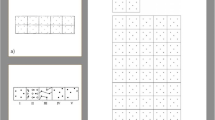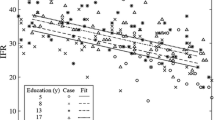Abstract
The Pyramids and Palm Tree Test (PPT) is a semantic memory test that measures the capacity to access detailed semantic information about words and pictures, necessary for the identification of the analogies, which link conceptually two perceptually, and functionally distinct entities. The present study aimed to provide normative data on a large sample of the elderly Italian population (N = 464; range of age = 49–94; range of education = 3–25) on both the word and the picture versions of the PPT. Results from multiple regression analyses showed that both age and education were significant predictors of performance in both the word and the picture versions of the PPT. Therefore, norms were calculated taking into account these demographic variables. The availability of normative data based on a large sample will allow a more reliable use of the PPT for clinical assessment in Italian-speaking dementia population.
Similar content being viewed by others
References
Howard D, Patterson K (1992) The Pyramids and Palm Trees Test. A test of semantic access from words and pictures. Thames Valley Company, Bury St. Edmunds
Hodges JR, Patterson K, Oxbury S, Funnell E (1992) Semantic dementia. Progressive fluent aphasia with temporal lobe atrophy. Brain 115:1783–1806
Rogers TT, Lambon Ralph MA, Garrard P et al (2004) The structure and deterioration of semantic memory: a neuropsychological and computational investigation. Psychol Rev 111:205–235
Rogers TT, Ivanoiu A, Patterson K, Hodges JR (2006) Semantic memory in Alzheimer’s disease and the frontotemporal dementias: a longitudinal study of 236 patients. Neuropsychology 20:319–335
Hodges JR, Patterson K (1995) Is semantic memory consistently impaired early in the course of Alzheimer Disease? Neuroanatomical and diagnostic implications. Neuropsychologia 4:441–459
Gudayol-Ferré E, Lara JP, Herrera-Guzman I et al (2008) Semantic memory as assessed by the Pyramids and Palm Trees Test: The impact of sociodemographic factors in a Spanish-speaking population. J Int Neuropsychol Soc 14:148–151
Rami L, Serradell M, Bosch B et al (2008) Normative data for the Boston Naming Test and the Pyramids and Palm Trees Test in the elderly Spanish population. J Clin Exp Neuropsychol 30:1–6
Folstein MF, Folstein SE, McHugh PR (1975) “Mini Mental State”: a practical method for grading the mental status of patients for the clinician. J Psychiatr Res 12:189–198
Bowles RP, Grimm KJ, McArdl JJ (2005) A structural factor analysis of vocabulary knowledge and relations to age. J Gerontol Psychol Sci 60B:234–241
Spinnler H, Tognoni G (1987) Standardizzazione e taratura italiana di test neuropsicologici. Ital J Neurol Sci. Suppl. 8
Carlesimo GA, Caltagirone C, Gainotti G, Nocentini U (1995) Batteria per la valutazione del deterioramento mentale (parte II). Descrizione e affidabilità diagnostica nell’identificazione di pazienti affetti da sindrome demenziale. Arch Psicol Neurol Psichiatr 56:471–488
Wilks SS (1941) Determination of sample sizes for setting tolerance limits. Ann Math Statist 12:91–96
Randolph C, Lansing AE, Ivnik RJ et al (1999) Determinants of confrontation naming performance. Arch Clin Neuropsychol 14:489–496
Da Silva CG, Pettersson KM, Faisca L et al (2004) The effects of literacy and education on the quantitative and qualitative aspects of semantic verbal fluency. J Clin Exp Neuropsychol 26:266–277
Lövden M, Rönnlund M, Nyberg L et al (2004) The extent of stability and change in episodic and semantic memory in old age: Demographic predictors of level and change. J Gerontol B Psychol Sci Soc Sci 59:130–134
Lindenberger U, Baltes PB (1997) Intellectual functioning in old and very old age: cross sectional results from the Berlin Aging Study. Psychol Aging 12:410–432
Bolla KI, Lindgren KN, Bonaccorsy C, Bleecker ML (1990) Predictors of verbal fluency (FAS) in the healthy elderly. J Clin Psychol 46:623–628
Mejia S, Pineda D, Alvarez LM, Ardila A (1998) Individual differences in memory and executive function abilities during normal aging. Int J Neurosci 9:271–284
Stine EL (1986) Attribute-based similarity perception in younger and older adults. Exp Aging Res 12:89–94
Cerella J, Fozard JL (1984) Lexical access and age. Dev Psychol 20:235–243
Howard DV, McAndrews MP, Lasaga ML (1980) Semantic priming of lexical decisions in young and old adults. J Gerontol 36:707–714
Mueller JH, Kausler DH, Faherty A, Oliveri M (1980) Reaction time as a function of age, anxiety, and typicality. Bull Psychon Soc 16:473–476
Balota DA, Duchek JM (1988) Age-related differences in lexical access, spreading activation, and simple pronunciation. Psychol Aging 3:84–93
Byrd M (1984) Age differences in retrieval of information from semantic memory. Exp Aging Res 10:29–33
Nyberg L, Maitland SB, Rönnlund M et al (2003) Selective adult age differences in an age-invariant multifactor model of declarative memory. Psychol Aging 18:149–160
Albert MS, Heller HS, Milberg W (1988) Changes in naming ability with age. Psychol Aging 3:173–178
Bäckman L, Nilsson LG (1996) Semantic memory functioning across the adult life span. Eur Psychol 1:27–33
Kaufmann AS (2001) WAIS–III IQs, Horn’s theory, and generational changes from young adulthood to old age. Intelligence 29:131–167
Acknowledgments
The present research was supported by a grant from Regione Campania 2004 (L.R: N.5, 28.03.2002) to Maria A. Brandimonte.
Author information
Authors and Affiliations
Corresponding author
Appendix
Appendix
Italian words used in the word version of the PPT
(the first word of each triads is the target stimulus)
Practice 1: Panciotto, Farfallino, Collana; Practice 2: Bottiglia, Tazza, Bicchiere; Practice 3: Pagliaccio, Leone, Giraffa; 1. Occhiali, Occhio, Orecchio; 2. Mani, Guanti, Pantofole; 3. Batteria, Lampada, Torcia; 4. Ditale, Ago, Filo; 5. Sella, Capra, Cavallo; 6. Ancora, Canoa, Nave; 7. Cuscino, Letto, Sedia; 8. Topi, Cane, Gatto; 9. Alberi, Cipolla, Mela; 10. Eschimese, Igloo, Casa; 11. Fiammiferi, Lampadina, Candela; 12. Piramide, Palma, Pino; 13. Croce, Chiesa, Castello; 14. Biglietto, Auto, Bus; 15. Ragnatela, Ape, Ragno; 16. Mulino, Narciso, Tulipano; 17. Carota, Agnello, Asino; 18. Tenda, Fuoco, Termosifone; 19. Formaggio, Coniglio, Topo; 20. Anello, Dito, Pollice; 21. Cuccia, Cane, Gatto; 22. Soldati, Chiesa, Castello; 23. Bruco, Farfalla, Libellula; 24. Lana, Cani, Pecore; 25. Gallo, Verme, Serpente; 26. Suora, Chiesa, Casa; 27. Pipistrello, Gufo, Picchio; 28. Poltrona, Scarponi, Pantofole; 29. Tronchi, Martello, Sega; 30. Uova, Gallina, Cigno; 31. Pozzanghera, Nuvole, Sole; 32. Razzo, Stella, Luna; 33. Topo, Gabbia, Cuccia; 34. Pastore, Topi, Pecore; 35. Trapano, Vite, Chiodo; 36. Pesce, Gatto, Cane; 37. Stetoscopio, Lingua, Cuore; 38. Medaglia, Soldati, Eschimese; 39. Spilla da Balia, Bambina, Neonato; 40. Ghiande, Asino, Maiale; 41. Neonato, Letto, Culla; 42. Latte,Mucca, Toro; 43. Rasoio, Mento, Naso; 44. Tenda, Porta, Finestra; 45. Ventilatore, Luna, Sole; 46. Lucchetto, Bicicletta, Auto; 47. Sentiero, Mani, Piedi; 48. Soffietto, Fuoco, Candela; 49. Maschera, Pagliaccio, Sindaco; 50. Lavagna, Tavolo, Banco; 51. Inchiostro, Matita, Penna; 52. Eschimese, Barca a Remi, Canoa.
Rights and permissions
About this article
Cite this article
Gamboz, N., Coluccia, E., Iavarone, A. et al. Normative data for the Pyramids and Palm Trees Test in the elderly Italian population. Neurol Sci 30, 453–458 (2009). https://doi.org/10.1007/s10072-009-0130-y
Received:
Accepted:
Published:
Issue Date:
DOI: https://doi.org/10.1007/s10072-009-0130-y




